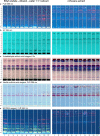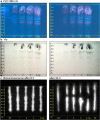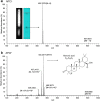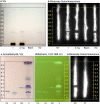Chemical and cytotoxicity profiles of 11 pink pepper (Schinus spp.) samples via non-targeted hyphenated high-performance thin-layer chromatography
- PMID: 37130976
- PMCID: PMC10154279
- DOI: 10.1007/s11306-023-02008-8
Chemical and cytotoxicity profiles of 11 pink pepper (Schinus spp.) samples via non-targeted hyphenated high-performance thin-layer chromatography
Abstract
Introduction: Pink pepper is a worldwide used spice that corresponds to the berries of two species, Schinus terebinthifolia Raddi or S. molle L. (Anacardiaceae). Toxic and allergic reactions by ingestion or contact with these plants were reported, and classical in vitro studies have highlighted the cytotoxic properties of apolar extracts from the fruits.
Objectives: Perform a non-targeted screening of 11 pink pepper samples for the detection and identification of individual cytotoxic substances.
Methods: After reversed-phase high-performance thin-layer chromatography (RP-HPTLC) separation of the extracts and multi-imaging (UV/Vis/FLD), cytotoxic compounds were detected by bioluminescence reduction from luciferase reporter cells (HEK 293 T-CMV-ELuc) applied directly on the adsorbent surface, followed by elution of detected cytotoxic substance into atmospheric-pressure chemical ionization high-resolution mass spectrometry (APCI-HRMS).
Results: Separations for mid-polar and non-polar fruit extracts demonstrated the selectivity of the method to different substance classes. One cytotoxic substance zone was tentatively assigned as moronic acid, a pentacyclic triterpenoid acid.
Conclusion: The developed non-targeted hyphenated RP-HPTLC-UV/Vis/FLD-bioluminescent cytotoxicity bioassay-FIA-APCI-HRMS method was successfully demonstrated for cytotoxicity screening (bioprofiling) and respective cytotoxin assignment.
Keywords: Bioassay; Bioprofiling; HPTLC; Schinus molle; Schinus terebinthifolia; Triterpene.
© 2023. The Author(s).
Conflict of interest statement
There are no competing interests to declare that are relevant to the content of this article.
Figures






Similar articles
-
Differentiation of Brazilian Peppertree (Schinus terebinthifolius Raddi) and Peruvian Peppertree (Schinus molle L.) Fruits by UHPLC-UV-MS Analysis of Their Anthocyanin and Biflavonoid Profiles.J Agric Food Chem. 2017 Jul 5;65(26):5330-5338. doi: 10.1021/acs.jafc.7b00480. Epub 2017 Jun 21. J Agric Food Chem. 2017. PMID: 28528547
-
Schinus terebinthifolius scale-up countercurrent chromatography (Part I): High performance countercurrent chromatography fractionation of triterpene acids with off-line detection using atmospheric pressure chemical ionization mass spectrometry.J Chromatogr A. 2015 Apr 10;1389:39-48. doi: 10.1016/j.chroma.2015.02.005. Epub 2015 Feb 11. J Chromatogr A. 2015. PMID: 25757818
-
Orthogonal Hyphenation of Planar and Liquid Chromatography for Mass Spectrometry of Biomarkers out of the Bioassay Matrix (NP-HPTLC-UV/vis/FLD-Bioassay-RP/IEX-HPLC-UV/vis-ESI-MS).Anal Chem. 2020 Jul 7;92(13):9057-9064. doi: 10.1021/acs.analchem.0c01251. Epub 2020 Jun 9. Anal Chem. 2020. PMID: 32452673
-
Phytochemical characterization and nutritional value of vegetable oils from ripe berries of Schinus terebinthifolia raddi and Schinus molle L., through extraction methods.Food Chem X. 2024 Jun 20;23:101580. doi: 10.1016/j.fochx.2024.101580. eCollection 2024 Oct 30. Food Chem X. 2024. PMID: 39027685 Free PMC article.
-
The genus Schinus (Anacardiaceae): a review on phytochemicals and biological aspects.Nat Prod Res. 2022 Sep;36(18):4839-4857. doi: 10.1080/14786419.2021.2012772. Epub 2021 Dec 9. Nat Prod Res. 2022. PMID: 34886735 Review.
References
Publication types
MeSH terms
Substances
LinkOut - more resources
Full Text Sources
Miscellaneous
